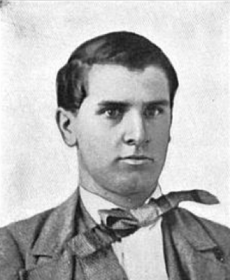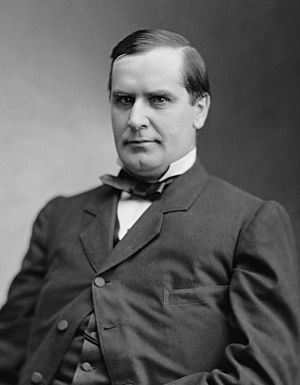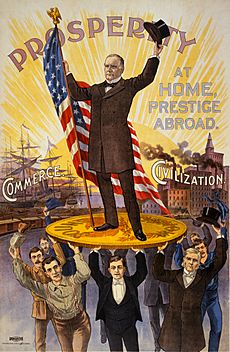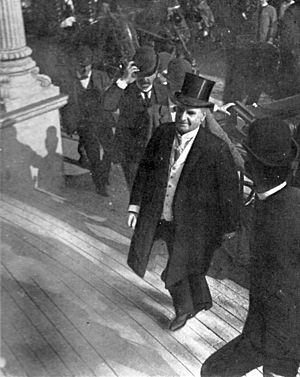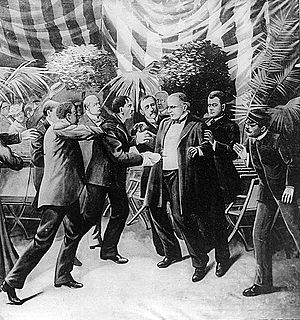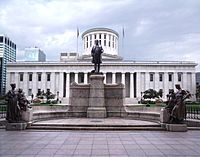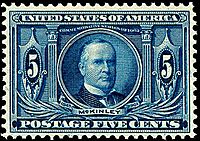William McKinley facts for kids
Quick facts for kids
William McKinley
|
|
|---|---|
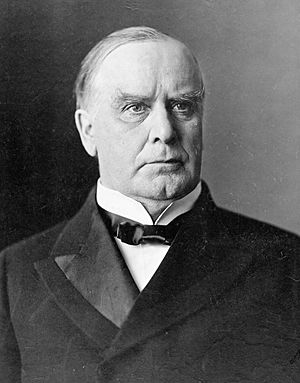
McKinley c. 1900
|
|
| 25th President of the United States | |
| In office March 4, 1897 – September 14, 1901 |
|
| Vice President |
|
| Preceded by | Grover Cleveland |
| Succeeded by | Theodore Roosevelt |
| 39th Governor of Ohio | |
| In office January 11, 1892 – January 13, 1896 |
|
| Lieutenant | Andrew L. Harris |
| Preceded by | James E. Campbell |
| Succeeded by | Asa S. Bushnell |
| Chair of the House Ways and Means Committee |
|
| In office March 4, 1889 – March 3, 1891 |
|
| Preceded by | Roger Q. Mills |
| Succeeded by | William M. Springer |
| Member of the U.S. House of Representatives from Ohio |
|
| In office March 4, 1885 – March 3, 1891 |
|
| Preceded by | David R. Paige |
| Succeeded by | Joseph D. Taylor |
| Constituency |
|
| In office March 4, 1877 – May 27, 1884 |
|
| Preceded by | Laurin D. Woodworth |
| Succeeded by | Jonathan H. Wallace |
| Constituency |
|
| Personal details | |
| Born |
William McKinley Jr.
January 29, 1843 Niles, Ohio, U.S. |
| Died | September 14, 1901 (aged 58) Buffalo, New York, U.S. |
| Cause of death | Assassination (Gangrene due to infection in gunshot wound) |
| Resting place | McKinley National Memorial, Canton, Ohio |
| Political party | Republican |
| Spouse | |
| Children | 2 |
| Parent |
|
| Education |
|
| Profession |
|
| Signature | |
| Military service | |
| Branch/service | U.S. Army (Union Army) |
| Years of service | 1861–1865 |
| Rank | Brevet Major |
| Unit | 23rd Ohio Infantry |
| Battles/wars | American Civil War |
William McKinley (born January 29, 1843 – died September 14, 1901) was the 25th president of the United States. He served from 1897 until he was assassinated in 1901. As a politician, he helped the Republican Party become very strong across the country. This lasted until the 1930s.
During his time as president, the United States won the Spanish–American War in 1898. The country gained control of Hawaii, Puerto Rico, the Philippines, and Cuba. McKinley also helped the economy recover after a tough time. He supported the gold standard for money and raised protective tariffs. These tariffs were taxes on foreign goods to help American businesses and keep wages high.
McKinley was a Republican and the last president to have fought in the American Civil War. He started as a regular soldier and ended as a major. After the war, he became a lawyer in Canton, Ohio. He married Ida Saxton. In 1876, McKinley was elected to Congress. There, he became known for his support of protective tariffs. He believed these tariffs would bring wealth to the nation.
His 1890 tariff law, called the McKinley Tariff, was very debated. He lost his election in 1890 because of it and new voting district lines. He then became governor of Ohio in 1891 and 1893. He tried to be fair to both businesses and workers. With help from his friend Mark Hanna, he became the Republican candidate for president in 1896. This was during a big economic downturn. He won against William Jennings Bryan by running a "front porch campaign". He promised "sound money" (the gold standard) and that high tariffs would bring back good times.
McKinley's presidency saw fast economic growth. He passed the 1897 Dingley Tariff to protect American factories. In 1900, he made the Gold Standard Act law. He wanted Spain to give Cuba its freedom peacefully. When talks failed, he asked Congress to declare war. The United States quickly won the Spanish–American War in 1898. As part of the peace deal, Spain gave Puerto Rico, Guam, and the Philippines to the U.S. Cuba was promised independence but stayed under U.S. control for a while. The U.S. also added the independent Republic of Hawaii in 1898. It became a U.S. territory.
Historians see McKinley's 1896 win as a major shift in American politics. It ended the political struggles after the Civil War. It started a time when the Republican Party was mostly in charge, known as the Fourth Party System. This period lasted until the 1930s. McKinley won again in the 1900 election. This campaign focused on America's role in the world, trade protection, and money issues.
His time as president ended suddenly. He was shot on September 6, 1901, by Leon Czolgosz, an anarchist. McKinley died eight days later. Vice President Theodore Roosevelt then became president. McKinley is generally seen as an above-average president. He helped America become more involved in world affairs and supported businesses. However, his decision to take over the Philippines is often criticized.
Contents
Early Life and Education
William McKinley Jr. was born in 1843 in Niles, Ohio. He was the seventh of nine children. His parents were William McKinley Sr. and Nancy McKinley. His family had English and Scots-Irish roots. They had moved to western Pennsylvania in the 1700s.
The McKinleys moved to Poland, Ohio, in 1852. This was so their children could go to better schools. William finished school at Poland Seminary in 1859. He then went to Allegheny College in Pennsylvania for a year. He had to return home in 1860 because he got sick and his family had money problems. He also studied at Mount Union College in Ohio. After college, he worked as a postal clerk and a teacher.
Service in the Civil War
Joining the Army
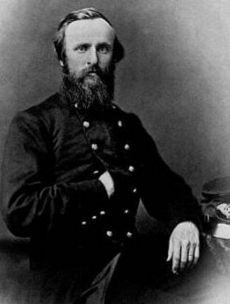
When the American Civil War began in 1861, many men from Ohio joined the army. William McKinley and his cousin signed up as private soldiers. They joined the Poland Guards in June 1861. This group later became part of the 23rd Ohio Infantry.
McKinley quickly learned how to be a soldier. He wrote letters to his hometown newspaper, praising the army and the Union cause. He was impressed by Major Rutherford B. Hayes, who would later become president. Hayes's way of dealing with the soldiers started a long friendship between them.
Life as a Soldier
In July 1861, McKinley's regiment went to western Virginia (now West Virginia). They fought their first battle in September at Carnifex Ferry. Three days later, McKinley started working in the army's supply office. He helped get supplies for his regiment. In April 1862, he was promoted to sergeant.
In September 1862, McKinley's regiment was sent to help other Union forces. They joined the Army of the Potomac and fought in the Battle of South Mountain. They then moved to Sharpsburg, Maryland, for the Battle of Antietam. This was one of the bloodiest battles of the war. McKinley was under heavy fire while bringing food to the soldiers. His regiment had many losses, but the Union army won.
Promotions and End of War

While in winter camp, McKinley was sent back to Ohio to find new soldiers. The governor of Ohio, David Tod, surprised him with a promotion to second lieutenant. This was for his bravery at Antietam. In 1864, McKinley was promoted to captain after a battle at Kernstown. He then joined General George Crook's staff.
McKinley fought in several more battles in the Shenandoah Valley. He helped rally troops at the Battle of Cedar Creek. After this battle, he voted for Abraham Lincoln in the presidential election. In February 1865, McKinley was transferred to General Winfield S. Hancock's staff. Just before the war ended, he received his final promotion to major. The war ended a few days later when Robert E. Lee surrendered. McKinley decided not to stay in the army and returned to Ohio.
Law Career and Family Life
After the Civil War ended in 1865, McKinley decided to become a lawyer. He studied law in Ohio and then at Albany Law School in New York. In March 1867, he passed his law exams.
He moved to Canton, Ohio, and opened his own law office. He became a successful lawyer. In 1869, he ran for and won the job of prosecuting attorney for Stark County. This was a surprise because Democrats usually held that job. He lost his re-election in 1871.
McKinley married Ida Saxton on January 25, 1871. Ida came from a well-known family in Canton. They had two daughters, Katherine (born 1871) and Ida (born 1873). Sadly, both daughters died young. The second Ida died the same year she was born. Katherine died two years later from typhoid fever. These losses deeply affected Ida, and her health became very poor. She developed epilepsy and relied heavily on her husband. William McKinley was a very devoted husband and took great care of her throughout his life.
In 1876, McKinley took on a big case. He defended a group of striking coal miners who were arrested. He won the case for most of them. This case made him popular with workers. It also introduced him to Mark Hanna, a rich businessman who would become his strongest supporter in politics.
Rising in Politics
A Voice for Tariffs
McKinley became a congressman in October 1877. He strongly believed in protective tariffs. These tariffs were taxes on goods from other countries. Their main goal was to make foreign goods more expensive. This way, American factories could sell their products for less and grow stronger. McKinley believed this would help American businesses and create good jobs.
He was chosen for the powerful House Ways and Means Committee in 1880. This showed he was becoming an important figure in national politics. He often spoke about the benefits of tariffs.
Facing Political Challenges
Democrats in Ohio tried to make it harder for McKinley to win elections. They changed the voting district lines to put him in areas where Democrats were stronger. This is called gerrymandering. But McKinley kept winning anyway. In 1878, he won even after his district was changed.

In 1890, Democrats changed his district again. They put his home county with a very strong Democratic county. The McKinley Tariff was also very unpopular at the time. Despite a big effort from the Republican Party, McKinley lost his election by a small number of votes.
Governor of Ohio
Even before leaving Congress, McKinley was asked to run for governor of Ohio. He won the election in 1891 by about 20,000 votes. As governor, McKinley had limited power. But Ohio was an important state, so its governor was a big national figure.
McKinley was fair to both businesses and workers. He helped pass laws that set up ways to settle work disputes. He also supported a law that fined employers who fired workers for being in a union.
In 1892, McKinley was chosen to lead the Republican National Convention. This made him a neutral figure, but many still saw him as a possible presidential candidate. He finished second in the voting for the presidential nomination, even though he wasn't actively seeking it.
In 1893, McKinley faced a personal financial crisis. A friend's business failed, and McKinley had guaranteed his loans. He owed over $100,000. Wealthy supporters, including Mark Hanna, helped him pay off the debt. This made many people feel sympathy for McKinley, and his popularity grew. He was easily re-elected governor in November 1893.
The 1896 Presidential Election
Getting the Nomination
William McKinley began preparing to run for president with the help of his close friend, Mark Hanna. Hanna used his money and organizing skills to build support for McKinley across the country. They focused on getting support from Southern states early on.
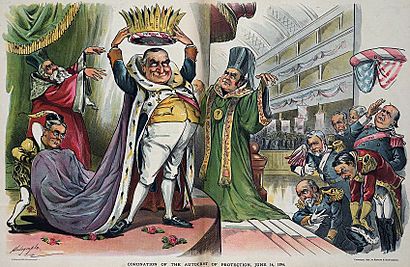
By the time the Republican convention started in St. Louis in June 1896, McKinley had enough support to win. He stayed in Canton, Ohio, and followed the events by phone. When Ohio's votes were counted, they gave McKinley the nomination. Thousands of people came to his home to celebrate. The convention chose Garret Hobart of New Jersey as his running mate for vice president.
The Campaign Against Bryan
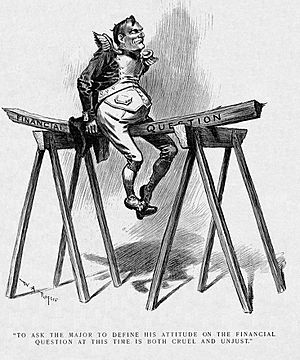
Before the election, McKinley had tried to take a middle ground on the "currency question." This was about whether the U.S. money should be based only on gold or on both gold and silver. But he decided the Republican Party should support the gold standard.
The economy was still bad, and many people wanted money to be based on silver. This issue divided the Democratic Party. The Democrats chose William Jennings Bryan for president. Bryan gave a famous "Cross of Gold speech" supporting silver. Bankers were worried about Bryan's ideas, thinking they would harm the economy. Mark Hanna raised a lot of money to support McKinley. They spent $3.5 million on speakers and millions of pamphlets. Bryan's campaign had much less money.
Bryan traveled the country by train, giving many speeches. Hanna wanted McKinley to do the same. But McKinley said Bryan was a better speaker. Instead, McKinley stayed at his home in Canton, Ohio. This became known as his "Front Porch Campaign". It was a very smart plan.
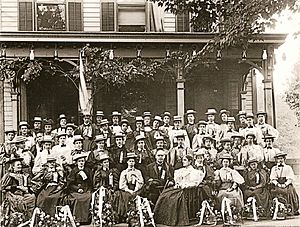
Every day except Sunday, McKinley met with groups of people on his front porch. Railroads offered cheap tickets to Canton, making it easy for people to visit. Spokesmen for the groups would talk to McKinley, and he would respond. His speeches were carefully planned. This was to avoid any unplanned comments that could cause problems.
Many newspapers did not support Bryan. Mark Hanna was often shown in cartoons as a rich man who controlled McKinley. These images still affect how people see Hanna and McKinley today.
The main battleground for the election was the Midwest. McKinley won all of the Northeast and Midwest. He won 51% of the votes and a clear majority in the Electoral College. Bryan had focused too much on the silver issue and did not appeal to city workers. McKinley won in almost every major city outside the South.
McKinley's victory in 1896 was a major turning point in American politics. It started a new period where the Republican Party was dominant. This period lasted for many years. McKinley's ideas of a strong government, protective tariffs, and gold-backed money won out.
McKinley's Presidency (1897–1901)
Starting His Term
McKinley became president on March 4, 1897. His wife and mother were there. He gave a long speech. He talked about changing tariffs and said the money issue would come after tariff laws. He also warned against getting involved in wars of conquest.
McKinley chose his cabinet members. He appointed John Sherman as Secretary of State. Sherman was well-known, but he was old and his health was declining. McKinley wanted to get Mark Hanna into the Senate, so Sherman was moved to the cabinet. McKinley also appointed Theodore Roosevelt as Assistant Secretary of the Navy. McKinley was hesitant about Roosevelt, saying, "I want peace and I am told that your friend Theodore is always getting into rows with everybody." But he made the appointment.
-
Chief Justice Melville Fuller swears in William McKinley as president; outgoing President Grover Cleveland at right
The Cuba Crisis and War
For many years, people in Cuba had been fighting for freedom from Spain. By 1895, this fight became a full war for independence. Spain's actions against the rebels became very harsh. Americans felt angry about Spain's policies. McKinley wanted a peaceful solution. He hoped Spain would give Cuba independence or at least some self-rule.
In January 1898, Spain offered some changes. But when an American official reported riots in Havana, McKinley sent the battleship USS Maine. On February 15, the Maine exploded and sank, killing 266 sailors. Many Americans believed Spain was responsible. McKinley waited for an investigation. On March 20, the investigation said the Maine was blown up by an underwater mine. People in Congress wanted war. McKinley kept trying to negotiate for Cuba's freedom. Spain refused. On April 11, McKinley asked Congress to decide. Congress declared war on April 20. They added the Teller Amendment, saying the U.S. would not take over Cuba.
McKinley used new technologies like the telegraph and telephone to control the war. He could direct the army and navy more closely than past presidents.
The U.S. Navy quickly won its first victory. Commodore George Dewey destroyed the Spanish fleet in the Battle of Manila Bay in the Philippines. This victory made the war bigger. It would decide the future of all of Spain's colonies in the Pacific. McKinley decided the U.S. should take over the Philippines. He believed Americans would want the islands as a prize of war.
In the Caribbean, American troops landed in Cuba. They fought the Spanish forces in the Battle of San Juan Hill on July 2. The Americans won, but both sides had many losses. The next day, Spain's navy in Cuba was destroyed in the largest naval battle of the war. Santiago surrendered on July 17, giving the U.S. control of Cuba. McKinley also ordered an invasion of Puerto Rico, which met little resistance. Spain could not resupply its forces and looked for a way to end the war.
Peace and New Territories

McKinley and his cabinet agreed that Spain had to leave Cuba and Puerto Rico. They disagreed about the Philippines. Some wanted to take all the islands, others just a naval base. Many Americans supported taking the Philippines. But some important leaders, like Bryan, were against it.
McKinley started peace talks with Spain. He demanded Cuba's freedom and that Puerto Rico be given to the U.S. The future of the Philippines would be discussed later. Spain agreed to a ceasefire on August 12. Peace talks began in Paris in September 1898. The Treaty of Paris was signed on December 18. The U.S. gained Puerto Rico, Guam, and the Philippines. Spain gave up its claims to Cuba. The U.S. paid Spain $20 million. McKinley worked hard to get the Senate to approve the treaty. They voted for it on February 6, 1899.
Hawaii Becomes a U.S. Territory
During the war, McKinley also worked to add the Republic of Hawaii to the U.S. Hawaii's queen had been overthrown in 1893 by business interests. Many Americans wanted to annex Hawaii. The war showed how important Pacific bases were. McKinley supported annexation and pushed Congress to act. He warned that if the U.S. did nothing, Hawaii might have a royalist uprising or be taken by Japan.
Instead of a treaty, McKinley supported a joint resolution by Congress. This resolution, called the Newlands Resolution, passed easily. McKinley signed it into law on July 8, 1898. McKinley believed that taking Hawaii was part of America's "manifest destiny".
Expanding Influence Globally
Open Door Policy in China
McKinley wanted to increase trade with Asia. He supported an "Open Door Policy" for China. This meant all nations could trade freely with China. No country should try to take over parts of China.
In 1900, American missionaries and other foreigners in China were in danger from the Boxer Rebellion. Westerners in Peking were surrounded. McKinley sent 5,000 troops to the city in June 1900. This was part of the China Relief Expedition. The westerners were rescued the next month. McKinley's actions set a new example for presidents to use the military without Congress's approval. After the rebellion, the U.S. continued its Open Door policy.
Panama Canal Plans
McKinley also worked with Britain on building a canal across Central America. The U.S. needed a way to move ships between the Atlantic and Pacific oceans more easily. The war showed how difficult it was to have a navy in two oceans. McKinley wanted to change an old treaty that stopped the U.S. from controlling a canal alone.
A new treaty was agreed upon. It said the U.S. could control a canal, but it had to be open to all ships and not fortified. The Senate rejected this. They wanted the U.S. to be able to fortify the canal. McKinley pushed for more talks. A new treaty was made and approved, but not until after McKinley's death. This led to the building of the Panama Canal later.
Economy and Money
McKinley was known for supporting high tariffs. He believed they protected American businesses and workers. With Republicans in charge of Congress, the Dingley Act was passed. This law raised taxes on many imported goods.
McKinley also dealt with the money issue. He wanted to officially make gold the standard for U.S. money. This was called the gold standard. In 1900, with the economy improving, McKinley urged Congress to pass a law for the gold standard. He signed the Gold Standard Act on March 14, 1900, using a gold pen.
Civil Rights and Reconciliation
After McKinley's election in 1896, many black Americans hoped for more equality. McKinley had spoken against lynching as governor. Most black voters supported him. However, McKinley's main goal was to unite the country after the Civil War. This meant he did not always push hard for black rights.
McKinley did appoint some black people to lower government jobs. But these appointments were fewer than under earlier Republican presidents. His administration did little about racial violence. When black postmasters were attacked, McKinley did not publicly condemn it. Some critics said he should have spoken out more.
In 1898, a group of white supremacists violently took over the government in Wilmington, North Carolina. McKinley did not send federal help to protect black citizens. He ignored pleas for help.
McKinley toured the South in late 1898. He promoted unity between the North and South. He visited Tuskegee Institute and met with the famous black educator Booker T. Washington. He also visited memorials to Confederate soldiers. In his tour, McKinley did not talk about racial tensions. While Southern whites welcomed him, many black people felt left out. Historians say McKinley did not fully address the racial issues of his time.
The 1900 Election
McKinley was very popular and easily won the Republican nomination for his second term in 1900. The only question was who would be his vice president. His first vice president, Garret Hobart, had died in 1899. McKinley considered a few people. But Theodore Roosevelt was the most popular choice. Roosevelt had been a hero in Cuba during the war. He was also governor of New York.
Mark Hanna did not want Roosevelt as vice president. He thought Roosevelt was too impulsive. But New York Senator Thomas C. Platt wanted Roosevelt out of New York politics. So, he pushed for Roosevelt to become vice president.
At the Republican convention in Philadelphia in June, McKinley was nominated again without any opposition. Roosevelt was then nominated for vice president. The Democrats again chose William Jennings Bryan for president. This set up a rematch of the 1896 election.
The issues had changed. Free silver was still a topic, but Republicans focused on winning the war and the good economy. Democrats focused on big businesses and said McKinley served rich companies. Bryan again traveled the country giving speeches. McKinley stayed home, giving only one speech to accept his nomination. Roosevelt became the main speaker for the campaign.
Bryan's campaigning did not excite voters as much as in 1896. McKinley was confident he would win again. On November 6, 1900, he won by a large margin. He won more votes than any Republican since 1872. Bryan only won four states outside the South. McKinley even won Bryan's home state of Nebraska.
Second Term and Assassination
Soon after his second inauguration on March 4, 1901, William and Ida McKinley began a six-week tour of the country. They traveled by train through the South, Southwest, and Pacific coast. They planned to visit the Pan-American Exposition in Buffalo, New York, in June. But Ida fell ill in California, so McKinley limited his public events. He postponed the Buffalo visit until September.
McKinley enjoyed meeting people. But his secretary, George B. Cortelyou, worried about his safety. There had been recent assassinations of leaders in Europe by anarchists. Cortelyou tried twice to cancel a public reception at the Buffalo exposition. McKinley refused. So, Cortelyou arranged for extra security. On September 5, McKinley gave a speech at the fairgrounds to 50,000 people. He talked about trade agreements with other countries. He wanted to help American businesses sell goods overseas.
A man named Leon Czolgosz wanted to assassinate McKinley. He had tried to get close the day before but failed. After hearing an anarchist speaker, Czolgosz decided to act. On September 6, he waited at the Temple of Music where the president was meeting the public. When Czolgosz reached the front of the line, he shot McKinley twice from close range.
McKinley told his helpers to tell Ida gently. He also asked them to stop the crowd that was attacking Czolgosz. This might have saved his assassin's life. McKinley was taken to the aid station. Doctors could not find the second bullet. An early X-ray machine was at the fair, but it was not used. McKinley was taken to the home of the exposition president.
For a few days, McKinley seemed to get better. Doctors gave hopeful updates. Cabinet members who had rushed to Buffalo left. Vice President Roosevelt went on a camping trip.
On the morning of September 13, McKinley's health got worse. Doctors realized he would not survive. At 2:15 a.m. on September 14, 1901, McKinley died. Theodore Roosevelt rushed back to Buffalo and became president. Czolgosz was found guilty of murder and executed on October 29, 1901.
Legacy and Memorials
Funeral and Resting Place
The nation felt great sadness when McKinley died. The stock market dropped, but people were focused on mourning. McKinley's casket was first in the White House. Then it lay in state at the Capitol. About 100,000 people saw the open casket there. Many waited hours in the rain. In Canton, Ohio, another 100,000 people saw it. A funeral service was held on September 19.
Ida McKinley was expected to die soon after her husband. But she lived until May 26, 1907. She stayed in Canton and often visited her husband's temporary resting place. She died just months before the large marble monument to her husband was finished in Canton. President Roosevelt dedicated it on September 30, 1907. William and Ida McKinley are buried there with their daughters.
Other Memorials
Many other memorials honor McKinley. There is a William McKinley Monument in front of the Ohio Statehouse in Columbus. A large statue is at his birthplace in Niles. Many schools across the U.S. are named after him.
In 1896, a gold miner named Denali, the tallest mountain in North America, after McKinley. The name was changed back to Denali in 1975. The Department of the Interior officially changed it in 2015.
McKinley's Place in History
Historians say McKinley was a very loved president when he died. But the energetic Theodore Roosevelt quickly became more famous. Roosevelt did not continue McKinley's plans for trade agreements. Over time, memories of McKinley faded. By 1920, his presidency was often seen as just a quiet time before Roosevelt's strong leadership.
Since the 1950s, historians have looked at McKinley more positively. He is usually ranked in the middle among presidents. Some say he followed public opinion more than he led it. But he successfully built a political group that kept Republicans in power for a generation.
Many important people who worked for McKinley later became major figures. These include George B. Cortelyou, who served in three cabinet jobs under Roosevelt. Charles G. Dawes became vice president under Coolidge. William R. Day became a Supreme Court justice. William Howard Taft became governor of the Philippines and later president. After McKinley's assassination, the United States Secret Service began protecting presidents.
One debated part of McKinley's presidency is the expansion of U.S. territory. The U.S. still controls most of the lands taken under McKinley, except the Philippines, which gained independence in 1946. This expansion is often seen as the start of the American empire. Historians still debate whether McKinley's actions were right. But one of his goals was to improve the lives of people in the Philippines and Cuba.
-
McKinley's tomb in Canton, Ohio
-
William McKinley Monument by Hermon MacNeil in front of the Ohio Statehouse, Columbus
-
McKinley Monument by Alexander Phimister Proctor in front of Buffalo City Hall, Buffalo
See also
 In Spanish: William McKinley para niños
In Spanish: William McKinley para niños
- List of presidents of the United States
- List of presidents of the United States by previous experience
- McKinley at Home, Canton, Ohio (1896 film)


